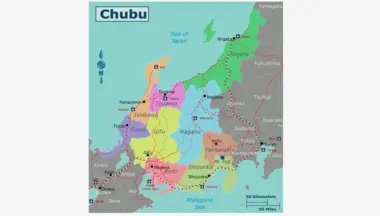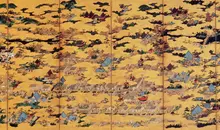The Chubu region 中部
- Pubblicato il : 18/12/2019
- Per : J.R.
- Youtube
Le Chûbu, entre Kanto et Kansai
Le Chûbu est la région centrale de l'île d'Honshu, nichée entre le Kanto à l'est, et le Kansai à l'ouest. Cette grande région est marquée par des paysages variés, et tout particulièrement son relief montagneux, avec les Alpes Japonaises et l'illustre Mont Fuji.
The geography and place of Chubu in Japan
The Chubu region, if it is less known than its neighbors Kanto (where Tokyo is located) and Kansai (Osaka and Kyoto), is nevertheless one of the most important among the eight that make up the archipelago. It is thus the third most populated region of Japan, with more than 21 million inhabitants. If these limits are sometimes vague (the regions not being official delimitations), it covers approximately 72,000 km 2, which makes it the second-largest region after Hokkaido.
Chubu means "central division", which illustrates its position well. It is made up of nine prefectures, including Shizuoka Prefecture in the south along the Pacific Ocean, Nagano Prefecture with the Japanese Alps in the center, Niigata Prefecture in the north along the Sea of Japan, and from Fukui to the west, stuck to Kansai.
The region is often broken down into three entities :
the Hokuriku region, a coastal strip on the Sea of Japan in the northwest, which is a rice-growing region,
the region of Koshinetsu (the "central highlands") and on the coast of the Sea of Japan, in the northeast (Niigata),
the Tokai region, to the south, a narrower area on the Pacific coast.
The three largest cities in the region are Nagoya, Nagano, and Niigata.
Tourism and the major sites of Chûbu
Chubu is often ignored by tourists in favor of Kanto and Kansai. However, this vast region is home to real nuggets and world-renowned sites. The Japanese Alps are of course one of the great attractions of Chubu, as well as Mount Fuji, a must in Japan.
The region also takes on its full meaning in winter: it then becomes the undisputed capital of Japan for winter sports. In summer, hikers will find their paradise in the Alps and around Mount Fuji.
Culturally, the region is also very rich. It is also home to three of the twelve-period castles still existing on the archipelago:
Inuyama Castle. Address: Kitakoken-65-2 Inuyama, Aichi 484-0082
Maruoka Castle in Sakai. Address: 910-0231 Fukui, Sakai, Maruokacho Kasumicho, 1−59
Matsumoto Castle. Address: 4-1 Marunouchi, Matsumoto, Nagano 390-0873
Even if it is not original, we also recommend the famous Castle of Echizen Ono, nicknamed "Castle in the sky", thanks to the phenomenon it enjoys: at dawn on autumn and winter mornings, it happens that the castle finds itself in a sea of clouds ...
What to see at Chubu?
Chûbu is a large region and it would be difficult to visit everything. However, some major sites, cities, or activities are unmissable. Discover the main points of interest of Chûbu :
It's hard to miss Fuji-San! The Five Lakes region is easily accessible from Tokyo, and the area is rich in holy mountain viewpoints, as well as numerous temples and shrines. If you prefer to climb, it is possible in summer.
Read also: Mount Fuji climbing routes
The Japanese Alps are the largest mountain range in the country. Whether in winter or summer, these mountains are home to sumptuous landscapes. The city of Matsumoto is an excellent starting point. Walkers will enjoy the best hiking trails, while winter sports enthusiasts can have fun on the best ski slopes.
Also in the Alps, near Nakano, don't miss the Jigokudani monkey park, well known for the Japanese monkeys that bathe the natural hot springs in winter! A real sight to see!
Read also :
Nagoya, the capital of Chûbu, boasts fine gastronomy based on miso but is also known for its sumo tournaments. Do not miss to visit the magnificent Tokugawa-en gardens.
Kanazawa is a highly recommended destination. Its former geisha quarters, its castle, as well as the Kenroku-en garden (one of the three most beautiful in the country), make it an unmissable destination.
Shizuoka is located at the foot of Mount Fuji. Marked by the famous shogun Ieyasu Tokugawa and by history, the city is home to many riches, including its very famous green tea.
Lost in the middle of the forest , not far from Fukui, the Eihei-ji Zen temple is a real, rather unknown treasure, ideal for a meditative retreat. Do not hesitate to spend one or more nights there.
In another register, Atami is a seaside town , not far from Tokyo, renowned for its beaches : the perfect destination in summer.
West of Shizuoka, Hamamatsu enjoys a superb natural environment, including Lake Hamana and the Nakatajima dunes.
Finally, the Chubu region is renowned for its sushi and tempura, but also its production of sake, and will therefore not fail to delight those with the most discriminating taste!





























